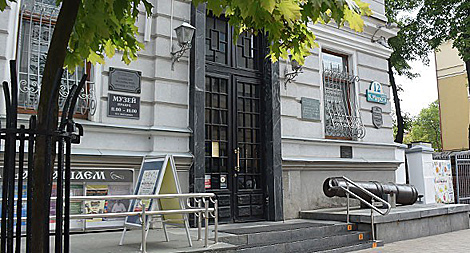Press releases
National Historical Museum of Belarus advances cooperation with Chinese partners

MINSK, 15 July (BelTA) – The National Historical Museum of Belarus has signed a cooperation agreement with the Guangdong-CIS International Technological Cooperation Union, BelTA has learned.
The document was signed by the museum’s Director Pavel Sapotko and the union’s Manager Lu Wei.
Lu Wei said: “Very good friendship is evolving between China and Belarus. Our union has worked for ten years already. We are fond of Belarusian culture and history, this is why we’ve signed such an agreement on cooperation. We intend to implement joint projects in the future.”
Apart from that, the National Historical Museum of Belarus hosted a presentation of Chinese traditional black brick tea. Technologies to make this kind of tea represent China’s intangible cultural legacy. Thanks to many years of tea production expertise Yantong Trade Company previously known as Baishaxi Tea Factory has developed ten varieties of black tea and 21 classic varieties from six provinces of China.
At present the Chinese side arranges many events relating to tea ceremonies and presentations of tea collections as a tool of cultural and public diplomacy in various countries within the framework of the Belt and Road initiative. The presentation was crowned with the signing of an agreement on cooperation between the National Historical Museum of Belarus and Yantong Company.
Pavel Sapotko said: “The first agreement is a framework one while the second one is more specific and geared towards scientific and cultural cooperation. We have found some contact points where we could work within the framework of this kind of cultural and scientific exchange. There are some interesting ideas. In particular, regarding the representation and popularization of our historical and cultural values. We are very interested in studying the approaches and the mechanisms. This way China’s legacy is not only preserved but also popularized within the context of national memory. This year is the year of the 70th anniversary of establishment of the People’s Republic of China. We arrange many projects. Next month we will have projects with the Shenyang Financial Museum and the Shanghai International Culture Association. This is why we are now in a phase of invigoration of the intercultural dialogue between Belarus and China.”
According to Pavel Sapotko, as possible projects they are considering the exchange of methodological literature, the implementation of translation programs, mutual publications in scientific journals, including in monographies on intangible legacy in Belarus and Russia. “We would like to use the potential and knowledge of Yantong Company and the Guangdong-CIS International Technological Cooperation Union as a whole as much as possible because the union works actively in the post-Soviet space. We have signed a framework agreement with the union, but we can say that we have already come up with bullet points for the future roadmap,” Pavel Sapotko said.







 print version
print version make home page
make home page add to bookmarks
add to bookmarks

